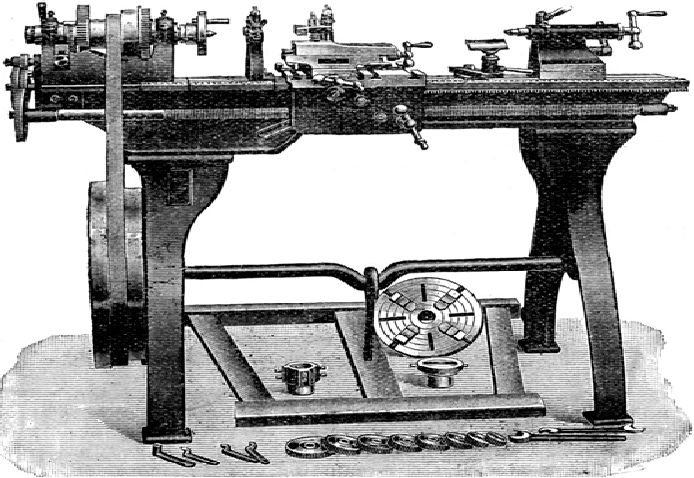
|
Standard Model No. L/KF1/CL with 21.25 inches between centres. Note the large |
||

|
The detachable gap bed model could be ordered with a centre height of 4 or 5.25 inches and with a capacity of either 21.5 or 30 inches between centres - which was reduced by one inch if a lever-action tailstock was |
||

|
|

|
4"-centre height Precision Screw-cutting Precision Lathe on the maker's "Self-contained Electric Motor Stand". Behind the lathe bed - and unfortunately not visible apart from its support arms - was a full-length oak tool tray. |
||

George Adams: larger screwcutting lathes
Looking very much like an IXL in both general layout and some specific details, the larger and heavier George Adams lathes were entirely conventional backgeared, screwcutting machines built in 5.25" and 6.25" centre heights and labelled, respectively, Models "A" and "B". They were almost certainly made Oscar Ehrlich - a well known and long-established lathe manufacture with premises at Chemnitz.
Built in three lengths the "A" was able to accommodate 20", 30" and 40" between centres and had a detachable gap in the bed able to admit material up to 16.25" in diameter. The saddle, which carried three T slots on both front and back wings, was guided along the bed by one V and one flat while the tailstock (in the usual manner) used the other V and flat.
Running in parallel, adjustable bronze bearings, the spindle was bored through 0.9" and carried a nose 19/16" in diameter with 12 threads per inch. The design of the spindle-thrust bearing varied from machine to machine: most were supplied with a ball race but on some, where room between the bearings was limited, a fibre washer was used instead. The 3-speed headstock cone pulley was driven by a 13/16" wide flat belt from a countershaft running at 130 revolutions per minute. The headstock and tailstock both carried No. 2 Morse taper centres - the tailstock having a convenient locking handle arranged to protrude to the rear and a substantial barrel-locking handle that drew together two halves of a split bar shaped to fit around the spindle. A dipper rod and oil reservoir - which at the time would have contained white lead, not oil, was provided for lubrication of the tailstock centre. The changewheels drove down to the 12 t.p.i leadscrew through a tumble-reverse mechanism neatly enclosed, as it was on many contemporary lathes, beneath the spindle and inside the headstock casting. The leadscrew was slotted and drove the power cross feed (surfacing) through long sliding key held within a worm wheel secured to the apron - and through which the leadscrew passed. The surfacing feed was engaged and disengaged by a push-pull knob on the apron front.
Similar in design to the "A", the larger Model "B" was available with between-centres' capacities of 59", 71" and 80" while the gap in the bed admitted work up to 19" in diameter. The headstock spindle was bored through 1.1" and carried a 1.75" diameter nose with 6-threads per inch; the headstock belt was 1.5" wide and driven by a countershaft turning at 120 rpm. The apron was arranged differently to that on the 5.25" lathe, with power sliding and surfacing selected by the raising and lowering of an arm. Strangely, the saddle arms were not T slotted, as on the smaller machine, so limiting its usefulness in remote locations where lathes were often called upon to perform any number of machining operations besides straightforward turning, facing and screwcutting.
Both "A" and "B" Models could be supplied on a treadle stand or with a power-driven countershaft - each type having plain bearings as standard but with the option, at extra cost, of roller bearings..

|
|
||